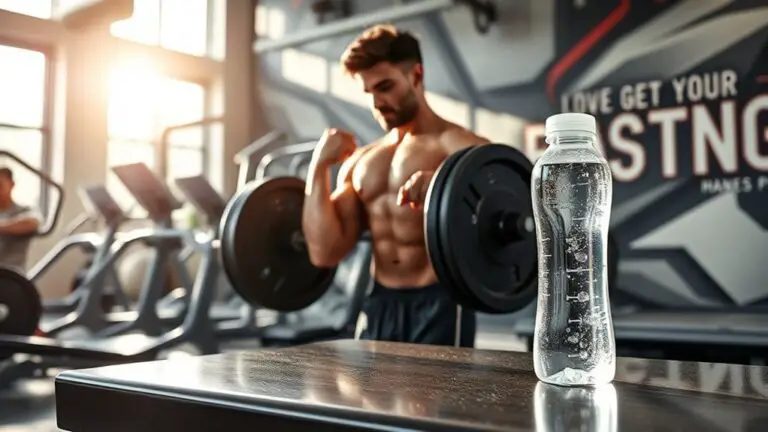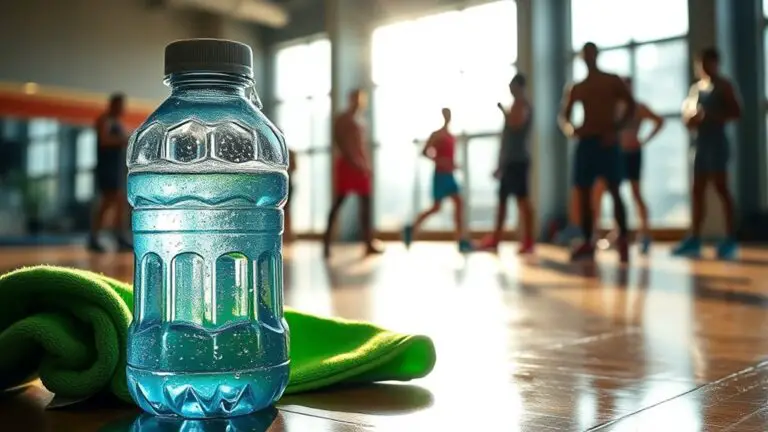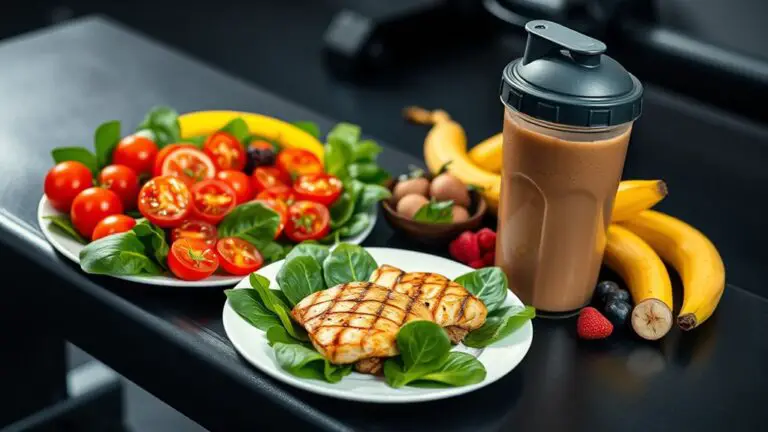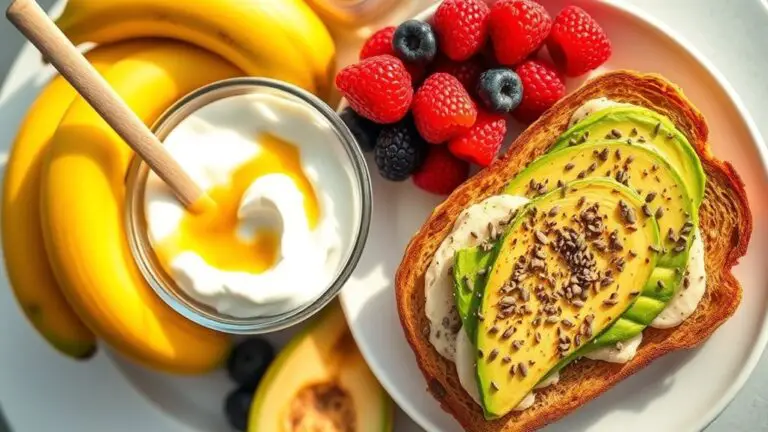How to Meal Prep for a Gym-Focused Diet
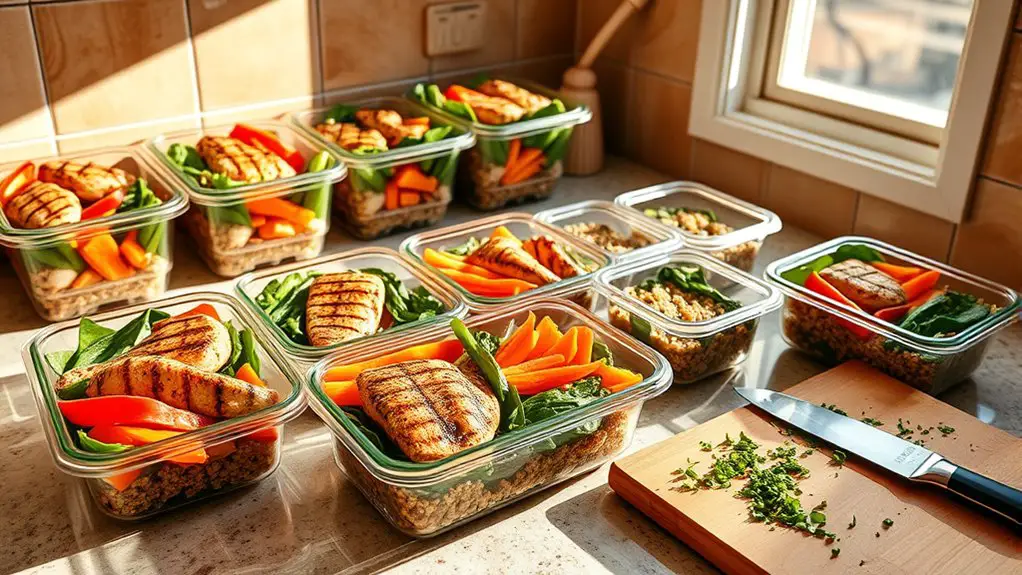
To meal prep for a gym-focused diet, start by understanding your macronutrient needs—aim for a balanced ratio of proteins, carbs, and fats. Plan your weekly menu with diverse recipes, focusing on lean proteins and plenty of vegetables. Invest in essential tools like a food scale and glass containers for storage. Practice portion control to meet your goals and avoid meal fatigue by incorporating variety. With a strategic approach, you can efficiently fuel your fitness journey while staying motivated. Discover more strategies for success.
Understanding Macronutrients for Optimal Performance
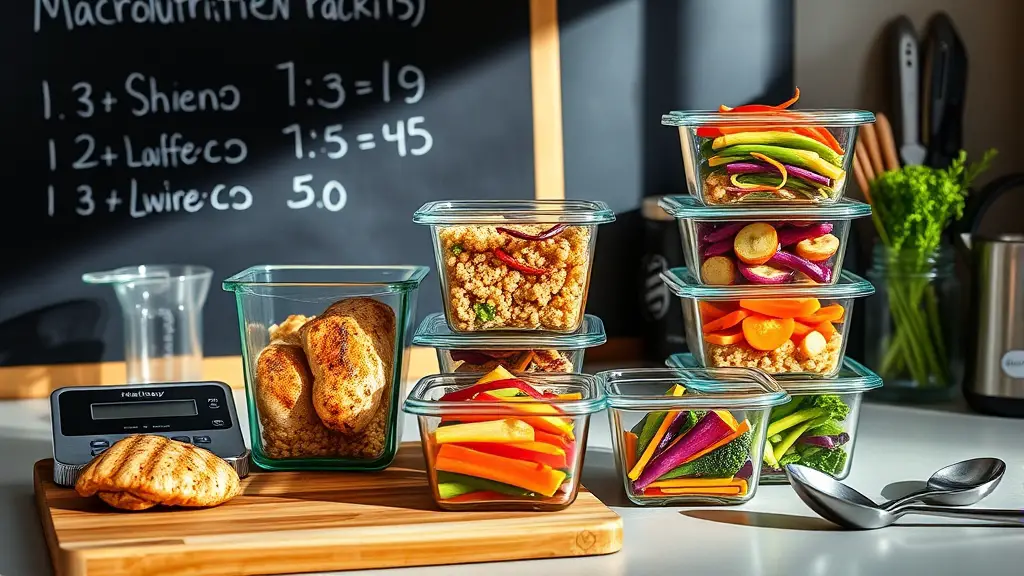
When you’re aiming for peak performance in the gym, understanding macronutrients becomes fundamental. Protein sources like chicken, fish, and legumes fuel muscle repair, while carbohydrate timing can greatly impact your energy levels during workouts. Consuming carbs before training provides immediate fuel, while post-workout carbs help replenish glycogen stores for recovery.
Don’t overlook fat intake; healthy fats can support hormone production and overall health, contributing to your performance goals. Working towards micronutrient balance is also essential—vitamins and minerals play critical roles in energy metabolism and recovery.
Implementing hydration strategies is key; staying well-hydrated enhances endurance and cognitive function. Meal timing should align with your workout schedule to maximize benefits, including pre workout snacks that elevate energy. Post workout recovery meals rich in protein and carbs aid muscle growth and restoration. By mastering these elements, you’ll set a solid foundation for your gym-focused diet.
Planning Your Weekly Menu
To effectively plan your weekly menu, start by evaluating your nutritional needs based on your fitness goals. Next, choose balanced recipes that incorporate the right macronutrients to fuel your workouts and recovery. Finally, organize a grocery list to guarantee you have all the necessary ingredients on hand for meal prep.
Assess Nutritional Needs
Before diving into meal prep, it’s vital to assess your nutritional needs based on your fitness goals and activity level. Understanding your caloric intake is critical for fueling your workouts and recovery. Start by identifying how many calories you need daily, then tailor your meals accordingly. Consider your dietary preferences—whether you’re vegan, vegetarian, or have specific allergies—to guarantee your meals are enjoyable and sustainable.
Here’s a simple table to help you categorize your needs:
| Nutritional Aspect | Example Values | Notes |
|---|---|---|
| Caloric Intake | 2,500 calories/day | Adjust based on goals |
| Macros Distribution | 40% carbs, 30% protein, 30% fats | Balance for energy and recovery |
| Meal Frequency | 5 meals/day | Keep energy levels stable |
Assessing these factors will lay the groundwork for effective meal prep.
Choose Balanced Recipes
Choosing balanced recipes is crucial for supporting your gym-focused diet, especially since they can directly impact your performance and recovery. Aim for meals that include a combination of healthy grains and lean proteins. Healthy grains, like quinoa and brown rice, provide the carbohydrates you need for energy, while lean proteins, such as chicken, turkey, or tofu, support muscle repair and growth. Incorporate plenty of vegetables for vitamins and minerals, which are essential for overall health. For snacks, consider options that combine protein and healthy fats, like Greek yogurt with nuts. By planning your weekly menu with these balanced recipes, you’ll guarantee your body receives the nutrients it needs to perform at its best and recover effectively.
Organize Grocery List
An organized grocery list can make or break your meal prep success, especially when following a gym-focused diet. Start by planning your weekly menu; this helps you identify what you’ll need. Consider incorporating seasonal ingredients, as they’re often fresher and more affordable. When budgeting for groceries, prioritize whole foods like lean proteins, whole grains, and plenty of fruits and vegetables. Aim to stick to your list while shopping to avoid impulse buys. You can also categorize items by section, such as produce, dairy, and pantry staples, to streamline your trip. Finally, keep your receipts to track your spending and adjust your grocery budgeting strategies for future weeks. This disciplined approach will set you up for meal prep success!
Essential Meal Prep Tools and Containers
To effectively prep meals for your gym-focused diet, having the right tools is essential. You’ll need must-have kitchen gadgets, quality storage containers, and helpful meal prep accessories to streamline the process and keep your meals fresh. Let’s explore what you really need to make your meal prep efficient and successful.
Must-Have Kitchen Tools
When diving into meal prep for a gym-focused diet, having the right kitchen tools can make all the difference in streamlining your process and enhancing your results. Start with essential kitchen gadgets like a sharp chef’s knife and a cutting board, which will speed up your chopping and slicing. A reliable food scale is vital for accurate portioning, ensuring you meet your macronutrient goals. Don’t forget a high-quality blender for smoothies and sauces, as well as a slow cooker or pressure cooker for easy, hands-off meal preparation. Silicone baking mats and a set of measuring cups are also meal prep essentials that will help you maintain consistency in your recipes. These tools will simplify your cooking experience and support your fitness journey.
Best Storage Containers
Effective meal prep hinges on having the right storage containers, as they play a crucial role in preserving the freshness and quality of your food. Opt for glass containers, which are durable and often microwave safe, making reheating convenient. Look for BPA free options to guarantee safety in your meals. Consider different portion sizes to cater to your dietary needs, and use meal prep labels to keep track of contents and dates. Eco-friendly choices are increasingly available, allowing you to store food responsibly. Choose containers with airtight lids to lock in freshness and maintain flavor. Stackable designs not only save space in your fridge but also make organization easier, streamlining your meal prep process.
Meal Prep Accessories
Having the right storage containers is just one part of a successful meal prep routine. To level up your prep game, consider investing in meal prep bags made from durable, BPA-free materials. These bags are perfect for organizing snacks or protein-rich foods, keeping everything fresh and accessible. For portion control, use containers that come with built-in measurements or dividers, ensuring you’re sticking to your dietary goals. Additionally, a food scale can help you accurately measure ingredients and maintain portion sizes. Don’t overlook kitchen tools like sharp knives, cutting boards, and microwave-safe lids, as they streamline the prep process. By equipping yourself with these essential accessories, you’ll make meal prepping efficient and enjoyable, supporting your gym-focused diet.
Batch Cooking: Time-Saving Techniques
Although many people think meal prep is time-consuming, batch cooking can actually streamline your weekly routine and make healthy eating more manageable. By dedicating a few hours each week, you can prepare multiple meals at once, saving you time during busy weekdays. Start with quick recipes that use similar ingredients, like stir-fries or casseroles, to maximize efficiency.
Once cooked, store meals in airtight containers for easy access. If you’re worried about spoilage, freezing meals is a smart option; just verify they’re properly cooled before you freeze them to maintain quality. Labeling containers with dates can help you keep track of freshness.
This method not only guarantees you’ve got nutritious options on hand but also cuts down on cooking and cleanup time. With these batch cooking techniques, you’ll find sticking to your gym-focused diet easier and more enjoyable.
Portion Control for Muscle Growth
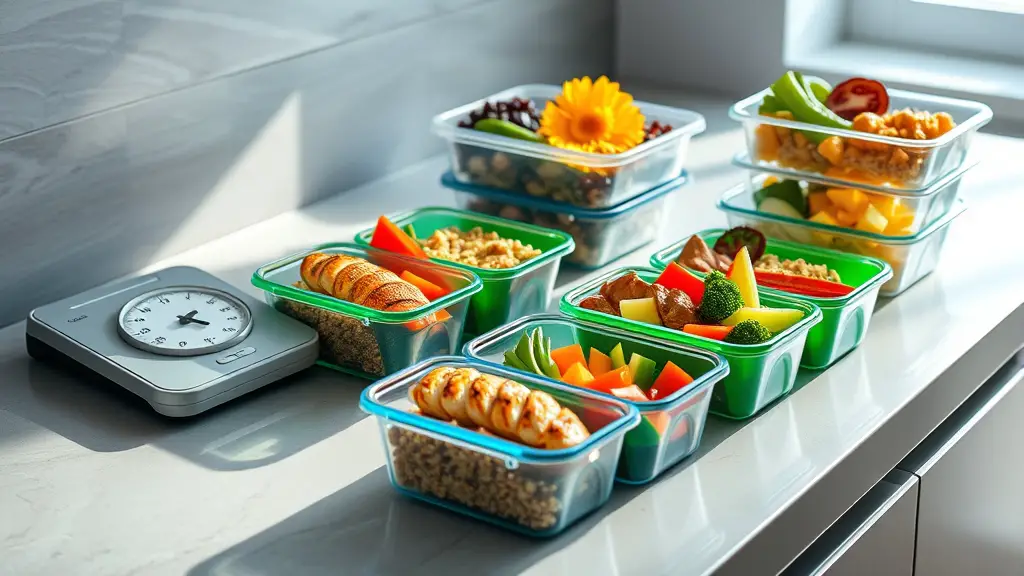
After getting the hang of batch cooking, the next step in optimizing your gym-focused diet is mastering portion control for muscle growth. Proper portion sizes are essential for achieving calorie balance, ensuring you consume enough nutrients without going overboard. Focus on protein timing; aim for a protein-rich meal every 3-4 hours to support muscle recovery and growth.
Here’s a quick reference table to help you visualize ideal portion sizes:
| Meal Type | Protein (grams) | Carbs (grams) |
|---|---|---|
| Breakfast | 20-30 | 30-50 |
| Snack | 15-20 | 15-25 |
| Lunch | 30-40 | 40-60 |
| Dinner | 30-40 | 40-60 |
| Post-Workout | 20-30 | 30-50 |
Maintain consistent meal frequency throughout the day to fuel your workouts effectively and promote muscle growth.
Incorporating Variety to Avoid Meal Fatigue
To keep your gym-focused diet enjoyable and sustainable, it’s important to incorporate variety into your meal prep. Embracing different meal themes each week can transform your routine. Experimenting with flavor swaps—like using spices from various cuisines—can elevate familiar dishes. Ingredient rotation guarantees you’re not stuck in a flavor rut and allows you to take advantage of seasonal produce.
Here are some ways to mix it up:
- Explore diverse cuisines to expand your taste profiles.
- Incorporate texture variations to keep meals interesting, like crunchy veggies or creamy sauces.
- Try culinary experiments with new recipes that challenge your cooking skills.
Storing and Reheating Your Prepped Meals
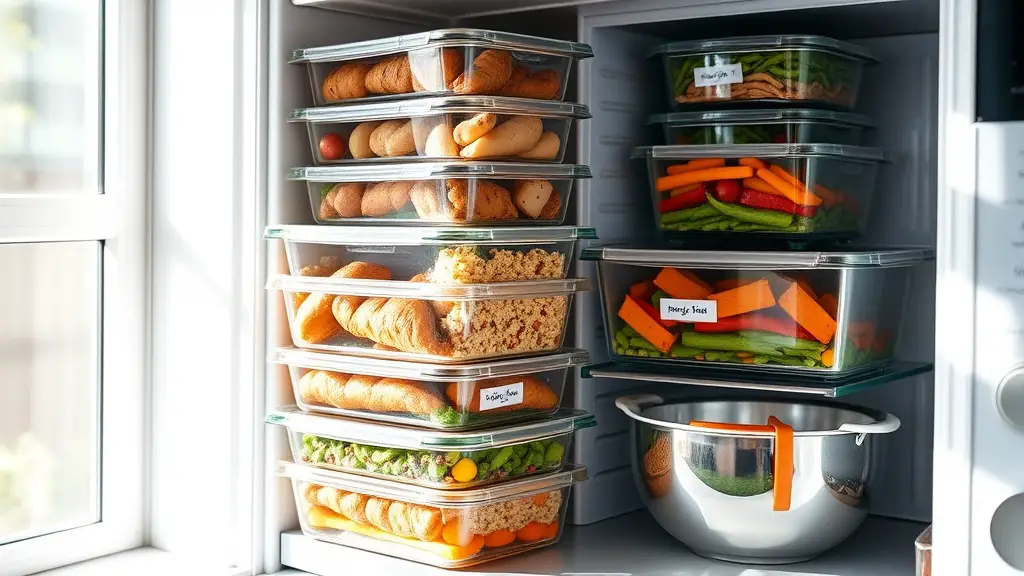
Maintaining variety in your meal prep is just the beginning; how you store and reheat your meals is equally important for preserving flavor and nutrition. Proper meal storage starts with using airtight containers that prevent moisture loss and bacterial growth. Glass containers are a great option since they don’t retain odors and are microwave-safe. Labeling your meals with dates can help you keep track of freshness.
When it comes to reheating techniques, avoid using high heat, which can dry out your food. Instead, opt for lower settings in the microwave or oven, adding a splash of water or broth to maintain moisture. If you’re using the stovetop, consider reheating your meals in a non-stick pan over medium heat. Remember, the goal is to enjoy your meals while keeping their nutritional value intact, so be mindful of how you store and reheat to maximize your meal prep efforts.
Staying Motivated and Adjusting Your Plan
While sticking to a gym-focused diet can be challenging, finding ways to stay motivated and making necessary adjustments to your meal plan can greatly enhance your success. Start by setting clear goals and tracking your progress. Consider using visualization techniques to see your future self, which can spark motivation during tough moments. Accountability partners can also help you stay on track, providing support when you face obstacles.
Staying motivated on a gym-focused diet requires clear goals, progress tracking, and the support of accountability partners.
- Celebrate achievements, no matter how small
- Implement a rewards system to treat yourself
- Embrace mindset shifts to maintain positivity
Don’t hesitate to adjust your routine as needed; flexibility can be key to long-term success. Incorporate motivational quotes into your daily life to inspire you. By focusing on these strategies, you’ll not only overcome challenges but also build a sustainable meal prep plan that aligns with your fitness goals.
Frequently Asked Questions
Can I Meal Prep for a Vegan Gym-Focused Diet?
Absolutely, you can meal prep for a vegan gym-focused diet! It’s all about finding that perfect balance of vegan protein sources like lentils, chickpeas, and quinoa. By planning your meals ahead, you can create meal variety that keeps you excited and nourished. Think stir-fries, salads, and wraps loaded with veggies and healthy fats. Just make certain you’re meeting your protein needs to support your workouts effectively. With a bit of creativity, you’ll thrive!
How Long Do Meal Prepped Items Last in the Fridge?
When you’re meal prepping, knowing how long your items last in the fridge is essential for food safety. Generally, meal storage guidelines suggest that cooked meals can stay fresh for about 3 to 4 days. However, it’s best to store them in airtight containers to maintain quality. If you’re unsure, always check for signs of spoilage before eating. Keeping track of these timelines helps guarantee you’re eating safely and healthily.
What Are Quick Protein Sources for Meal Prep?
When you’re looking for quick protein sources for meal prep, consider incorporating canned tuna and Greek yogurt. Canned tuna’s not only convenient but also packed with protein and omega-3 fatty acids. Greek yogurt is another excellent option, rich in protein and versatile for breakfast or snacks. Both can easily be added to salads, wraps, or smoothies, making meal prep efficient and nutritious. You’ll find these options help you meet your protein needs effortlessly.
How Can I Prevent My Meals From Becoming Bland?
To prevent your meals from becoming bland, focus on spice variety and flavor enhancers. Experiment with different herbs, spices, and marinades to create layers of flavor. Incorporating citrus juices, garlic, or ginger can elevate your dishes considerably. Don’t forget about umami-rich ingredients like soy sauce or nutritional yeast. You can also try infusing oils with herbs for a unique twist. By mixing these elements, you’ll keep your meals exciting and enjoyable throughout the week.
Is It Better to Freeze or Refrigerate Prepped Meals?
You might worry that freezing will ruin the taste of your meals, but that’s not true! Freezing actually preserves nutrients and flavors longer than refrigeration. When you freeze, you can enjoy meals up to three months later without losing quality. For refrigeration, make sure to store meals in airtight containers and consume them within a week to prevent spoilage. By balancing freezing benefits with smart refrigeration tips, you’ll keep your meals fresh and tasty!
